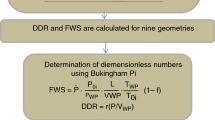Abstract.
The last stages of most steam turbines operate in wet steam, resulting in water erosion of the rotor blades and the reduction of turbine efficiency. Accurate measurement of steam wetness is the key to ensure an efficient and stable operation of steam turbines. The equivalent complex permittivity model of wet steam was established by Maxwell-Wagner non-homogeneous dielectric theory, and the complex permittivity distribution of frequency and temperature changes of saturated water, dry saturated steam, and wet steam was derived. The measurement experiments verified the above properties of dry saturated steam and wet steam. The complex permittivity of the wet steam is similar to that for the dry saturated steam. The real part increases with increasing frequency and temperature. When the frequency is large or the temperature is low, the real part approaches 1. The imaginary part increases first and then decreases with the increase of frequency. In addition, with the increase of temperature, the imaginary part becomes larger. When the temperature is low, the imaginary part is close to 0, which is independent of the frequency.
Graphical abstract

Similar content being viewed by others
References
M. Vatanmakan, E. Lakzian, M.R. Mahpeykar, Energy 147, 701 (2018)
X. Yu, Z. Xiao, D. Xie, C. Wang, C. Wang, Int. J. Heat Mass Transfer 84, 642 (2015)
G.I. Ilieva, Eng. Fail. Anal. 70, 90 (2016)
V. Petr, M. Kolovratnik, Proc. Inst. Mech. Eng. Part A: J. Power Energy 228, 206 (2014)
M. Schatz, T. Eberle, M. Gruebel, J. Starzmann, D.M. Vogt, N. Suerken, J. Eng. Gas Turbines Power 137, 64 (2015)
J. Starzmann, M.V. Casey, J.F. Mayer, J. Power Energy 228, 216 (2013)
D. Cirmirakis, A. Demosthenous, N. Saeidi, IEEE Sens. J. 13, 900 (2013)
H. Matbouly, N. Boubekeur, F. Domingue, IEEE Trans. Microw. Theory Techn. 63, 4150 (2015)
V.N. Makhlaichuk, N.P. Malomuzh, J. Mol. Liq. 253, 330 (2018)
I.V. Vancea, Int. J. Geom. Methods Mod. Phys. 15, 147 (2017)
J. Zhou, F. Schmid, Eur. Phys. J. E 36, 216 (2013)
L. Xu, J. Yuan, Appl. Therm. Eng. 76, 357 (2015)
L. Frunza, A. Schönhals, H. Kosslick, Eur. Phys. J. E 26, 76 (2008)
J.C. Del Valle, C. Arago, M.I. Marques, J.A. Gonzalo, Ferroelectrics 466, 166 (2014)
E. Sanchez, C.F. Torres, P. Guillen, G. Larrazabal, Math. Comput. Model. 57, 2140 (2013)
M. Agarwal, A.K. Behera, M.K. Meshram, Appl. Phys. A 122, 1 (2016)
Z. Han, K. Yang, S. Tian, Turbine Technol. 549, (2003)
R.F. Tian, L.P. Du, P.F. Zhang, Asia-Pacific Power and Energy Engineering Conference (APPEE
H.J. Kretzschmar, A.H. Harvey, K. Knobloch, J. Eng. Gas Turbines Power 131, 4 (2009)
K. Cui, Y. Song, H. Chen, J. Braz. Soc. Mech. Sci. Eng. 38, 1 (2016)
Z. Han, J. Qian, International Conference on Electronic Measurement & Instruments (IEEE, 2009) ISBN:1-604-1-607
V. Hric, J. Halama, International Conference on Numerical Analysis and Applied Mathematics (AIP Publishing LLC, 2015)
Author information
Authors and Affiliations
Corresponding author
Additional information
Publisher’s Note
The EPJ Publishers remain neutral with regard to jurisdictional claims in published maps and institutional affiliations.
Rights and permissions
About this article
Cite this article
Qian, J., Gu, Q., Yao, H. et al. Dielectric properties of wet steam based on a double relaxation time model. Eur. Phys. J. E 42, 22 (2019). https://doi.org/10.1140/epje/i2019-11783-1
Received:
Accepted:
Published:
DOI: https://doi.org/10.1140/epje/i2019-11783-1



